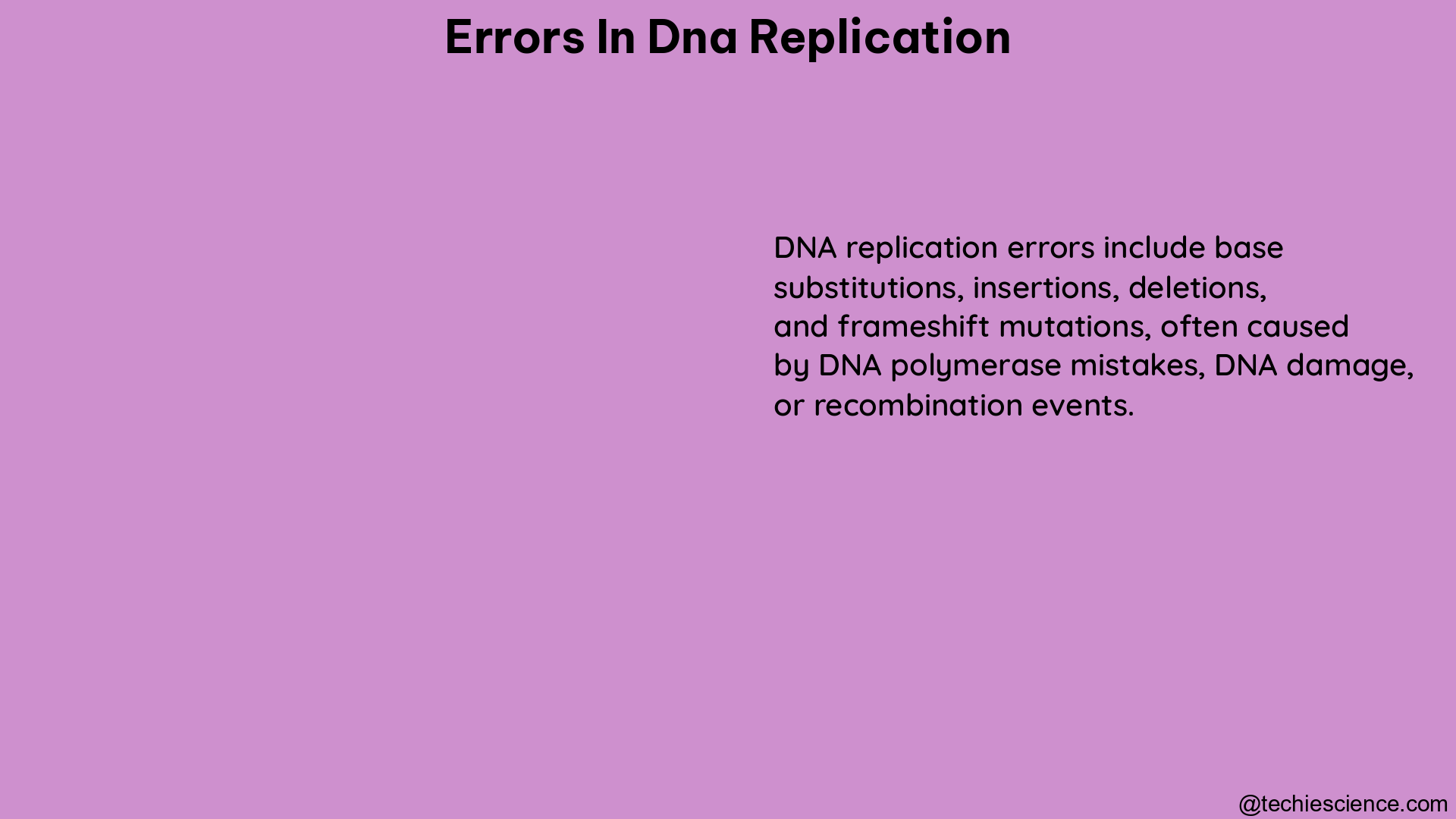DNA replication is a fundamental process in all living organisms, responsible for the accurate duplication of genetic information. However, errors can occur during this process, leading to mutations that can have significant consequences for the organism. Understanding the mechanisms and factors that contribute to errors in DNA replication is crucial for understanding the origins of genetic diversity, disease, and evolution.
Factors Influencing DNA Replication Fidelity
The fidelity of DNA replication is determined by several key factors, including:
-
DNA Polymerase: DNA polymerases are the enzymes responsible for catalyzing the addition of nucleotides during DNA replication. Different DNA polymerases have varying degrees of accuracy, with some being more prone to making errors than others.
-
Proofreading Function: Many DNA polymerases have a proofreading function, which allows them to detect and correct mismatched nucleotides during replication. This proofreading activity is critical for maintaining the fidelity of DNA replication.
-
Mismatch Repair: Mismatch repair systems in the cell can identify and correct errors that occur during DNA replication, further enhancing the overall fidelity of the process.
-
Nucleotide Supply: The availability and balance of the four DNA nucleotides (adenine, thymine, guanine, and cytosine) can also influence the accuracy of DNA replication. Imbalances in the nucleotide pool can lead to increased error rates.
-
DNA Template Condition: The condition of the DNA template, such as the presence of lesions or damage, can also impact the fidelity of DNA replication, as the polymerase may have difficulty accurately replicating the damaged template.
Measuring Errors in DNA Replication

Quantifying errors in DNA replication has been a significant challenge due to the rarity of these events. Traditional methods, such as transfecting replication products into bacteria for clonal amplification and sequencing, have limitations in their ability to detect and quantify errors at base resolution.
To overcome these limitations, a high-throughput sequencing assay has been developed to map in vitro DNA replication errors at the single-molecule level. This assay uses a barcoding strategy, where each replication product is tagged with a unique nucleotide sequence before amplification. This allows multiple sequencing reads of the same product to be compared, enabling the identification and removal of sequencing errors.
The key advantages of this high-throughput sequencing assay include:
-
Base Resolution Quantification: The assay can rapidly detect a large number of polymerase errors at base resolution over any template substrate, providing a comprehensive and accurate quantification of a DNA polymerase’s error spectrum.
-
Elimination of Quantification Bias: The barcoding strategy allows for the removal of sequencing errors, ensuring that the observed errors are true replication errors and not artifacts introduced during the sequencing process.
-
Characterization of Error Hotspots: In addition to measuring the average error rate of a polymerase, this assay can be used to identify error hotspots, which are regions of the genome where errors occur more frequently than in other regions.
-
Lesion Bypass Fidelity: The assay can also be used to assess the ability of a polymerase to accurately replicate DNA that contains lesions or damage, known as lesion bypass fidelity.
Implications of Errors in DNA Replication
Errors in DNA replication can have significant consequences for an organism, as they can lead to the introduction of mutations. These mutations can have a range of effects, from being neutral or beneficial to being deleterious and potentially leading to the development of genetic diseases or cancer.
The impact of errors in DNA replication can be influenced by several factors, including:
-
Mutation Type: Different types of mutations, such as substitutions, insertions, or deletions, can have varying effects on the function of the affected gene or protein.
-
Mutation Location: The location of the mutation within the genome can also influence its impact, as mutations in coding regions, regulatory regions, or non-coding regions can have different consequences.
-
Mutation Frequency: The frequency of a particular mutation can also be important, as rare mutations may have less impact on the overall fitness of the organism, while more common mutations may have a more significant effect.
-
Cellular Mechanisms: Cellular mechanisms, such as DNA repair pathways and cell cycle checkpoints, can play a role in mitigating the impact of errors in DNA replication by detecting and correcting these errors or triggering cell death in cells with severe DNA damage.
Strategies for Improving DNA Replication Fidelity
Given the importance of maintaining the fidelity of DNA replication, researchers have explored various strategies to improve the accuracy of this process. Some of these strategies include:
-
Polymerase Engineering: Efforts have been made to engineer DNA polymerases with enhanced proofreading and error-correction capabilities, which can improve the overall fidelity of DNA replication.
-
Nucleotide Pool Regulation: Maintaining a balanced and optimal supply of the four DNA nucleotides can help reduce errors during replication, as imbalances in the nucleotide pool can lead to increased error rates.
-
Mismatch Repair Enhancement: Strengthening the mismatch repair systems in cells can further improve the detection and correction of errors that occur during DNA replication.
-
Lesion Bypass Optimization: Improving the ability of DNA polymerases to accurately replicate DNA that contains lesions or damage can help reduce the introduction of errors during replication.
-
Cellular Stress Management: Addressing cellular stressors, such as oxidative stress or environmental mutagens, can help maintain the integrity of the DNA template and reduce the likelihood of errors during replication.
By understanding the mechanisms and factors that contribute to errors in DNA replication, researchers can develop more effective strategies to improve the fidelity of this critical process, with potential applications in areas such as genetic engineering, disease prevention, and evolutionary biology.
References:
- Genomic methods for measuring DNA replication dynamics – PMC. (n.d.). Retrieved from https://www.ncbi.nlm.nih.gov/pmc/articles/PMC7131883/
- DNA Replication—A Matter of Fidelity – ScienceDirect.com. (n.d.). Retrieved from https://www.sciencedirect.com/science/article/pii/S109727651630140X
- Mapping DNA polymerase errors by single-molecule sequencing. (n.d.). Retrieved from https://www.ncbi.nlm.nih.gov/pmc/articles/PMC5291262/
- Replication fidelity of DNA polymerases. (n.d.). Retrieved from https://www.ncbi.nlm.nih.gov/pmc/articles/PMC3072894/
- The impact of DNA replication errors on genome evolution. (n.d.). Retrieved from https://www.ncbi.nlm.nih.gov/pmc/articles/PMC6172976/
- Mechanisms of DNA replication fidelity. (n.d.). Retrieved from https://www.ncbi.nlm.nih.gov/pmc/articles/PMC3072894/
- Strategies for improving the fidelity of DNA replication. (n.d.). Retrieved from https://www.ncbi.nlm.nih.gov/pmc/articles/PMC4524054/

Hi….I am Aheli Dey, I have completed my Masters in Zoology. My specialization is in Parasitology and Immunology. I am very enthusiastic in learning new things. I prefer both hard and smart work.